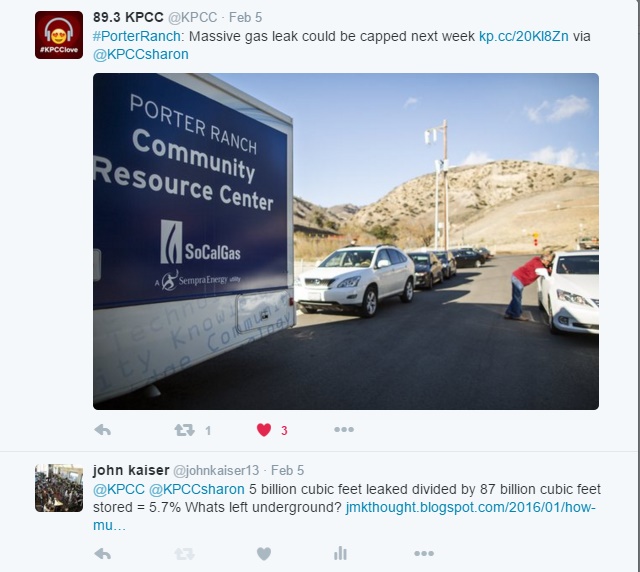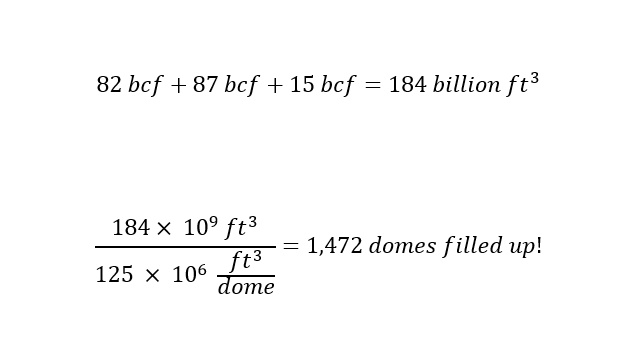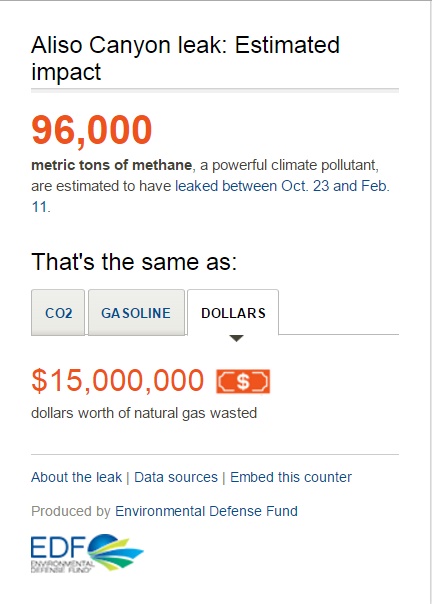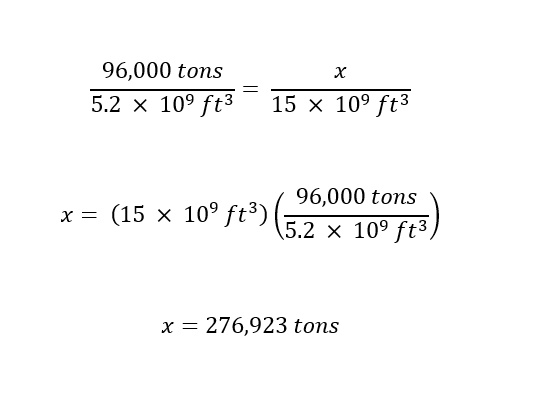Again, How Much Gas Is Stored Underground?
I thought the answer was simple but inconceivable and answered already. The reported amount available to be stored at the Aliso Canyon Gas Storage Facility has been reported to be around 87 billion cubic feet of methane gas. The space underground -- around 8000 feet -- is an old oil well that was drained. Sound about right? According to new information, there may be a lot more gas. Read on to find out.
In my earlier blog post (a little over a week ago), I had an estimate of the amount of gas that is stored underground at the Aliso Canyon Gas Storage Facility -- based on accounts from the SoCalGas facility webpage. These estimates were shown through dimensional analysis to be inconceivable to say the least. Here were the results in summary:
1) 87 billion cubic feet of gas amounted to the equivalent space inside 696 Super Domes or 2351 Empire State Buildings.
2) The reservoir is 8000 feet below ground which is the equivalent to stacking 5 and 1/2 Empire State Buildings on top of one another.
Initially, when I calculated the above values I was blown away. Since then, I have been spreading the message of the results on every 'Facebook' page that tagged 'PorterRanchGasLeak' or 'MethaneGasLeak'. For what reason? If I were a resident near the storage facility, I would be asking the following questions of all responsible parties:
1) Why did the well shut down take such a long time?
2) Is the reason related to a resulting pressure change on the other 114 wells?
3) How much gas is left underground?
4) If the wells were shutdown, how high is the chance of a leak (in the event of an earthquake)?
5) How probable are leaks from the other 114 wells on the Aliso Canyon Site?
These are just a few questions that come to mind based on my earlier calculations. As I mentioned, I started spreading the message via 'Facebook' and 'Twitter' over the last week with the following posts -- which many of the readers have seen. I think the inconceivable results of dimensional analysis would drive any resident to push hard for answers. Here is an example post from me:
I did not know what type of responses to expect (if any) from posting the link to my post. Interestingly enough, a reporter from KPCC (Radio in Pasadena, California) -- Sharon McNary -- responded to my post. I am grateful for the information that she provided to me. One of the wonderful aspects of using social media is the ability to interact with reporters. She clarified the present situation at Porter Ranch as she is collecting information to report on to the public.
On top of that clarification, she provided a great example of the situation by analogy with a 'bagpipe' and the air required on part of the player to drive the instrument. Driving gas out of an previous oil well/reservoir is handled similarly. Her analogy is shown below:
According to Sharon McNary, the well still holds a tremendous amount of gas. How can we visualize the volume of the stored gas? We can use the volume of the Mercedez Benz Super Dome in Louisiana -- which is shown below and has an interior volume of 125 million cubic feet:
As you can see, the dome is no small structure. Therefore, using the interior space as a volume to compare to an astronomical (huge) number -- volume of spill -- is completely appropriate. First, lets take the value initially conveyed to me from Sharon McNary to be 184 billion cubic feet. This would include the cushion gas, the interior storage capacity of the reservoir and the remaining 15 billion cubic feet. I performed the calculation and the numbers below are what we get:
Wow! And I thought that the previous number of 696 super domes from 87 billion cubic feet was large (the result of the last post). The number keeps drifting away from us. Inconceivable to say the least. The number should not just be alarming in magnitude. If the amount of gas still underground is anywhere near that value then -- the current leak is nothing in comparison. Why?
I expressed the current leak as a percentage of the total 184 billion cubic feet below:
Now do you see why I am so concerned? The amount that has already leaking in a few months -- 5.2 billion cubic feet is nothing compared to the amount being reported by Sharon McNary. Of course, later, on February 10th, she posted an update is reported with figures that might bring more ease or not depending on the angle from which you view the numbers. The last calculation involving 15 billion cubic feet of methane above will become clearer below.
What Is The Potential Of A Full Blown Leak?
According to an article released on KPCC by Sharon Mcnary titled "Sorting Out Porter Ranch Fact vs. Fiction" there is still around 15 billion cubic feet of 'purchasable' gas in the storage facility. That amount is on top of the 'cushion gas' of 82 billion cubic feet. Again, the 'cushion gas' ensures that the well is pressurized and the gas company can retrieve gas from any of the 115 wells. Therefore, a constant pressure is provided by 82 billion cubic feet. Here is an excerpt from the article:
Aliso Canyon's operations are near-stalled right now. It has been barred from injecting more gas since the leak began, and it won't be able to resume until a time-consuming set of safety tests is completed on the other 114 or so active gas wells there. The California Public Utilities Commission estimates it could be months before it starts operating normally. So, will we run out of gas?Let's look at the numbers.Normally the gas field can hold 86 billion cubic feet available for delivery to customers. The gas is held underground at very high pressure by these wells, which act like valves. Today, the field holds only 15 billion cubic feet of gas that could be shipped to customers, so the pressure is much lower. That's the lowest amount of gas that the CPUC estimates the gas company can keep underground and still serve the L.A. basin enough gas to heat on a streak of very cold days or serve L.A. Department of Water and Power's electric generating plants this summer on the hottest days.
I should clarify that the excerpt above is an answer to the following question stated in the article by the author:
Will the region run out of gas or power this summer if Aliso Canyon is closes?
More important is the integrity of the remaining wells (114 of them) and SoCalGas's ability to manage them. With the calculated amount of gas 82 bcf + 15 bcf = 97 bcf -- 97 billion cubic feet of gas, the gas company should be calming concerns of the residents around the storage facility. I would be super skeptical if I were a resident.
There is no doubt that the amount of gas leaked thus far is inconceivable and not acceptable. If these large companies are able to get away with not accurately reporting numbers along with their ability to control such leaks, why should the public trust them? If we look at the numbers that were tallied or counted on by the Environment Defense Fund's 'automatic counter,' here are the results shown below:
(1) Equivalent amount of gasoline burned:
(2) Equivalent amount of Carbon Dioxide Gas:
(3) Equivalent amount of money lost in methane sales:
Now, remember that the remaining amount of gas minus the 'cushion gas' is 15 billion cubic feet, what if another well (or multiple wells) were to bust? The current tallied numbers by the Environmental Protection Agency is shown below in a table:
This is an updated table from that posted in my earlier blog post. Data from mid February was not present -- because February was not here at the time. Further, the data contained in the table above is the final data -- considering that the 'well' was shut down on the 11th of February.
As the reader can see by inspection of the table, the final amount (estimated of course) of methane that was leaked since the beginning of the leak (back in October of 2014) was estimated to be around 5.2 billion cubic feet (bcf).
I mentioned above that there should be caution on part of the resident that lives in Porter Ranch with the proclamation that homes are safe to return to now with the 'plugging' of the well. I would be skeptical of that statement. Not that the homes are dangerous themselves (although, there might be residual methane and additive gases absorbed on surfaces), but because of the remaining amount of gas still stored in the Aliso Canyon Facility.
Lets use the two values that might be of interest that are taken from the excerpt of the updated report (fact vs. rumor) by Sharon McNary. The two values of interest are 15 billion cubic feet (that can be sold to the public) and 82 billion cubic feet (amount of cushion gas). We can start by asking the following question:
What if another 'well' broke or multiple 'wells' broke down and caused a further leak? How much gas could escape?
Or stated differently,
How much gas is still underground (updated by Sharon McNary)?
Below are the results of the calculated amount of super domes that could be filled. The first calculation uses the 15 billion cubic feet that can be sold is shown below:
As you can see, the amount is not 'insignificant' and should give the reader a certain amount of skepticism toward regulators, gas company employees, etc. What about the cushion gas? What about if a portion of the cushion gas were to escape into the atmosphere? I calculated the 'upper amount' of methane (cushion + purchasable) that would be possible to escape into the atmosphere. the results are shown below:
Basically, the amount of gas that could potentially leak into the atmosphere is could fill anywhere between 120 to 776 Mercedez Benz Super Domes. OMG. That should cause the reader (and resident of Porter Ranch) to take a step back and think about the types of questions that need to be answered by the regulators and gas company employees before returning to their homes.
Since we have the range of volume that the gas would fill up if any leaked out of the well, we can go back and look at the data collected by the Environmental Defense Fund in more detail. We know that according to the 'counter' that was set up, there was 96,000 metric tons of methane emitted into the atmosphere. Furthermore, we know from their estimations that the following amounts were calculated: (1) Equivalent to burning 900,000,000 gallons of fuel (gasoline), (2) Equivalent amount of Carbon Dioxide gas 8,000,000 metric tons released into the atmosphere, and (3) Amount of money lost in sales of the methane gas at market value $15,000,000. That is alot no matter which way you view the amount leaked from the Aliso Canyon Storage Facility.
Last, but not least, how about if we extend out these values to obtain a range of leaked gas had the well continued to spew gas. Meaning, with the reported amount left in the 'reservoir' what is the largest value of leaked gas. In order to calculate the range, we must set up a the calculation based on ratios. The ratio of leaked gas to that of what is left over. That is the ratio of 5.2 to 15 billion cubic feet of gas along with the leaked amount of 96,000 tons from October 23, 2015 to February 11, 2016. The calculation can be set up and executed as follows below:
This means that if the remaining 15 billion cubic feet of methane were to escape into the atmosphere, the Environmental Defense Counter would read that roughly 276, 923 tons of Methane had escaped. If the 'cushion' gas of methane is included, the number increases as shown below:
Each of these values would be obtainable by simply multiplying the current values at 5.2 billion cubic feet by a factor of 3. The ratio gives a little more accurate estimation. But since, the numbers vary with such a high degree of variance that are reported, the rough approximation is sufficient for the non-scientist.
Conclusion
Having the ability to carry out the calculations is a useful tool. Especially as the Porter Ranch residents are now in a phase of preparing 'legal battles' against SoCalGas. Understanding the magnitude of the leak is very important when trying to figure out the exact damages that should be awarded. But first and foremost, as residents, people should ask the company further questions to really get to the bottom of the remaining amounts of gas. After all, they are the remaining residents on the land. The real people who suffer are those who have been displaced. They should at least have some 'ammo' when discussing the current status of their neighborhood with regulation agencies.
These numbers are enormous. The companies and regulation agencies should be trying their hardest to show the largest amount of transparency and listen with concern to the public surrounding the Aliso Canyon Storage Facility. Hopefully, the magnitude of the disaster will stay at current levels. Have a great day!!














This comment has been removed by the author.
ReplyDeleteComment posted twice. My apologies.
DeleteNo worries for the double comment. Thank you for the comment Ty.
DeleteI'm sorry, but some of your math is making some incredibly large assumptions, and misrepresentations.
ReplyDeleteYou haven't shown any consideration that the 90bcf(Billion cubic feet) of gas is only if the gas is at standardized temperatures and pressure. The industry standard for that measurement is that the gas will occupy 1 cubic foot at 1 atmosphere, at 60 degrees F. The gas is stored under pressure, so it is condensed. There is not a void the size of 1,472 super domes down there.
The bagpipe effect is an accurate picture. Yes it does take another 87bcf of gas to push out the "usable" 87bcf. But, once it gets done pushing the gas out, it would be at atmospheric pressure and wouldn't be able to leak. The weight of the atmosphere above it will hold it in place.
At minimum capacities, to keep the system simpler, and ultimately safer, they would only need to keep the reservoir pressure a little over sales line pressures. Doing so allows them to withdraw the gas without having to use a vacuum, followed by a compressor to push the gas out to your water heater. Which, by the way, the gas AFTER the meter on the side of your house is only at 1/2 a psi. For a reference the tires on your bicycle are probably at 35psi or higher. During full storage capacity, they would keep the pressure of the reservoir just below what it was before they ever started extracting anything from it. The reason to stop at that pressure? Because that is where mother nature set the relief valve at.
Think about it, the natural gas is naturally occurring, it will only build up to the point the reservoir can contain it. After that point the gas would migrate to another reservoir pocket, or, of it finds a way, to the surface and atmosphere.
After working with the Department of Environmental Quality on Wyoming for several years, I have seen natural gas reservoirs that naturally hold pressures from 350psi, all the way up to 13,000psi.
Honestly, there is pockets of natural gas and oil all over the place. Because of cost and environmental impact, the oil and gas industry only drills where they can see a large enough reservoir to make it with the effort. If we are really going to be this fearful of this storage facility, perhaps we need to be more concerned with the small reservoirs that aren't developed at all, and basically unmarked. Major earthquake could just as easily release them. Which could be more hazardous because those reservoirs aren't filled with odorized gas. And being untested, could possibly contain things much more hazardous than methane, such as hydrogen sulfide gas.
Hello Ty,
DeleteNow worries about my great approximation(or gross assumptions) for the subject at hand. All points that you list above are completely valid (of course, you do not need me to tell you this)! Right about now, you might be asking yourself -- then why did you 'misrepresent' the data? Let me explain briefly.
As you mentioned, the volumes listed are those reported to the public. Part of my mission is to cast the number (magnitude) into a conceivable light. In this case, there seems to exist no lens to really drive home the magnitude of the amount of stored gas underground. The LARGE ASSUMPTION that I did do was to imply that the void was as large as the volume of gas stored (in this case, 87 bcf + 82 bcf + 15 bcf). If this was in fact true (as you previously pointed out), the gas would not be able to be extracted out of the ground. The volume(s) of gas that I used in my calculations are expressed at Standard Temperature and Pressure.
In general chemistry, we commonly think (and teach) of gases as 'Ideal' (non-interacting, point particles, ideal behavior). Of course, in real life, gases behavior 'non-uniformly' -- that is gas molecules will stick to one another and compress along with interact with each other elastically. To really accurately represent such behavior requires us to express the system in a 'virial expansion' and include all 'Boyle terms' (virial coefficients) in the expansion to account for both stickiness and repulsive behavior. For the purpose of getting the reader to think of volumes of gas stored underground, treating the system like an ideal system is appropriate to spur conversation. The real treatment of gases is completely interesting to myself and my colleagues who love to think of such concepts and realistic situations (extreme pressures, temperatures, etc.) -- which brings me to the next point.
I had no previous understanding of the pressures that real gases are kept at underneath ground in such a reservoir. So, thank you for that information. I totally agree that the void is not the actual size of the volume that I stated. The pressures that you mention are very large. Yes, a bicycle tire varies from 45 psi (mountain bike) to 110 psi (road bike) depending on the tire geometry. Although, the pressures that you speak of even cause more concern regarding the Porter Ranch residents. The purpose of my blog post is to get the public thinking about dimensional analysis. Part of that process is clarification of the LARGE assumptions that are made in the process. Hopefully, that discussion will lead to a better regulatory environment and mitigate such a disaster in the future. Every well needs to be inspected. The gas company has been relatively quiet with respect to volumes of gas and pressures stored in their facilities. The public deserves to be informed. Professionals like you have helped by pointing out assumptions which lead to misrepresentations. I believe that clearing up such misrepresentations through education is easier than having no discussion at all.
Commonly, the use of assumptions are under debate at a University. Some professors are adamantly against assumptions. Others are for assumptions (and misrepresentations) at the general chemistry/physics level which lead to clarification at the upper division or graduate school level.
I would like to thank you for your comment. Your insight is very appreciated and I invite you to comment on any other blog posts that appear on this site. I am completely willing to learn new ideas and clarify my posts through discussions -- such as this one. If you have any further questions, please do not hesitate to comment.
I will admit that the values you have stated will have me running some calculations in the next few days. The public should be very worried about various gas reservoirs and earthquakes in the region. I agree 100%. Have a good evening.
Sincerely,
Mike